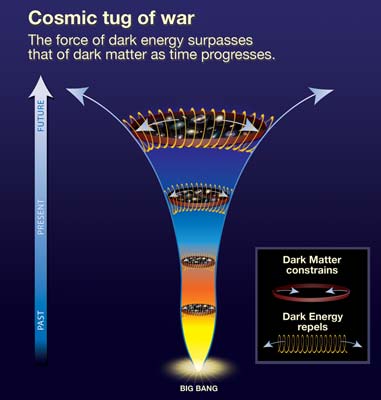Webster Cash’s New Worlds concept, a starshade and telescope mission to directly image exoplanets, may not have received NASA Discovery funding this time around, but its creator isn’t daunted. In a recent e-mail, Cash called the concept “…so robust that we aren’t even viewing this as a setback. It’s more of a lost opportunity.”
But Cash also provided an interesting speculation — how about merging the starshade with the Joint Dark Energy Mission (JDEM)? Aimed at teasing out details about the mysterious repulsive force responsible for the universe’s continuing acceleration, JDEM is in its research and development phase, with three mission concepts currently under scrutiny. All involve close study of Type 1a supernovae, objects whose known luminosity makes them ideal for measuring the universe’s expansion.
While we wait to see whether synergy develops between exoplanet imaging and JDEM, the dark energy news continues to come in. We learned a bit more yesterday, when NASA presented Hubble results showing that whatever the force is, it has been present in the universe since the earliest days. In fact, evidence from these supernovae studies shows that dark energy was a factor nine billion years ago, and that its strength has not changed with time.
The battle between gravity and dark energy was initially won by gravity as the universe’s expansion rate slowed, but five to six billion years ago the repulsive force of dark energy began to overtake it. Crucial to the work — and the evidence for this seems strong — is the assumption that the ‘standard candles’ being used, the Type 1a supernovae JDEM will also study, have not changed in the past ten billion years. That being the case, we can draw conclusions that provide us with the deepest understanding yet of the strength of dark energy and its constancy.

Credit: NASA, ESA, and A. Feild (STScI)
While researching the dark energy announcement, I was pleased to see that Clifford Johnson (USC) is now hosting a weblog of his own called Asymptotia (you’ve doubtless read him on Cosmic Variance). Johnson notes that for all the usefulness of the Hubble study, we still don’t know what dark energy is. From his post:
It could well be the repulsive force given by a simple cosmological constant (energy density of the vacuum), or it could still be due to a dynamical field, as in a quintessence model. I suppose that this new data set serves the purpose of ruling out some dynamical models, but I’d imagine that it leaves a wide class of dynamical models as still candidates.
The Hubble data are useful, in other words, and indicative of the progress we’re making in understanding the effects of dark energy, but it is remarkable that so dominant a force on the cosmic scale should remain such a mystery. Johnson’s whole post, in which he casts a somewhat skeptical eye on NASA’s announcement strategy for the dark energy story, is well worth your time.


Au contraire, we know exactly what “dark energy” is. Redshifts are dependent upon c. The speed of light has been changing for billions of years, making redshifts appear to accelerate.
As you see from their press release, some people believe that light from fireflies is constant.
The “tired light” hypothesis is dead. It was found inconsistent with the evidence. There’s also pretty good evidence that C hasn’t changed by more than a percent or so since pretty early on.
Light from fireflies seems to obey the inverse square law like any other light.